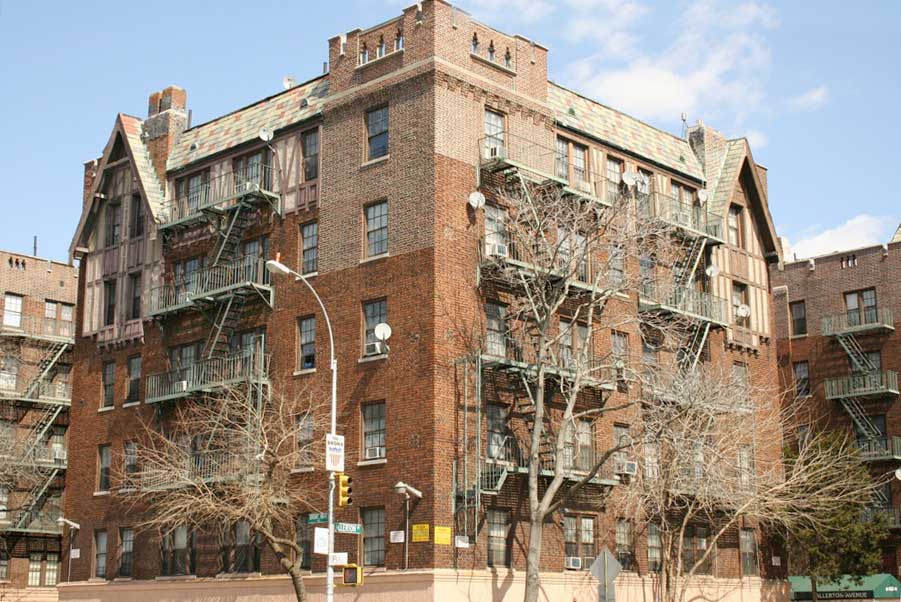The COOPS
 Photo: Emilio Guerra
Photo: Emilio Guerra
First House:
Bronx Park East to Barker Ave.
between Allerton Ave. and Britton St.
Springsteen & Goldhammer
1927
Second House:
Bronx Park East to Barker Ave. between Britton St. and Arnow Ave.
Norman Jessor of Springsteen & Goldhammer
The Coops was erected as a social and architectural experiment. In 1927, New York State law made the construction of cooperative housing legal for the first time. Under the law, the residents of the cooperative development purchased and owned shares in the co-op corporation. The corporation provided each shareholder with a proprietary lease to an apartment. The resident then paid a monthly maintenance fee to the corporation to pay for the underlying mortgage on the building and all operational expenses. An elected board made up of residents ran the corporation. The corporation was not to make a profit, just to break even. The law’s purpose was to provide some form of home ownership to citizens who could not afford to purchase single-family homes by themselves.
A group of young, radical leftist workers in Manhattan seized upon the law to plan an ideal cooperative community. Most of them were immigrants from Tsarist Russia where Marxist ideas were rife. They believed that running such a cooperative corporation would give the working class the experience they would need to run all of society when the expected Marxist revolution overturned the capitalist system.
These radical workers formed the United Workers’ Cooperative Organization. They sold shares in their Workers’ Cooperative Colony (its official name) at five dollars apiece. They planned to have working people surrounded by beauty, living in sunshine-filled apartments with high ceilings and cross ventilation. At least one room, preferably the bedroom, receives some direct sunshine. The massive building complex is divided into sections, and only three or four apartments share a floor in each section. Single-room apartments were for unmarried workers. There were kitchenettes, rather than full kitchens, so that mothers and wives would not be separated from the rest of the family while preparing meals.
In addition, the workers participated in the democratic functioning of the educational, social, artistic, humanitarian and economic enterprises of the project. Thus, the complex was provided with public rooms to house children’s schools, a library, lecture halls, and other public functions. Their children would be physically and mentally well rounded and develop a social conscience. Cooperative membership was restricted to workers and small businessmen who did not employ others. Most shareholders came from the needle trades, with some carpenters and ironworkers, and one doctor, one dentist and one librarian.
The Workers’ Cooperative Colony purchased land along Bronx Park East north of Allerton Avenue. The first house, completed in 1927, is accessed through a flowered, hedged and grassy courtyard. Off of it, there are several entrances, each one leading to a different section of the brick building. Each entrance is trimmed in terra cotta, on which each has a different molded motif. One of them displays a hammer on one side and a sickle on the other. On the exterior, the top floor and the roof end with a neo-Tudor half-timbered design. The second house, erected two years later, replicates the major elements of the original structure, but the neo-Tudor and the terra cotta designs were eliminated. From the beginning, residents called the complex, “The Coops” (not Co-ops).
The Great Depression seriously impacted the social experiment. Jobless residents could not pay the maintenance fees. The board allowed them to stay. Some moved in as boarders with neighbors. Renters evicted from private apartment houses nearby were invited to occupy empty apartments in the Coops, but they paid no money either. By 1933, the corporation could not pay its underlying mortgage to the bank. The bank agreed to accept only the interest on the mortgage for ten years to allow the corporation time to fix the problem. However, by 1943, the problem remained, and the bank foreclosed. The Coops was sold to a private investor and it remains a rental complex today, instead of a co-operative enterprise. Yet, today’s rental residents still proudly call it “The Coops.”
Lloyd Ultan